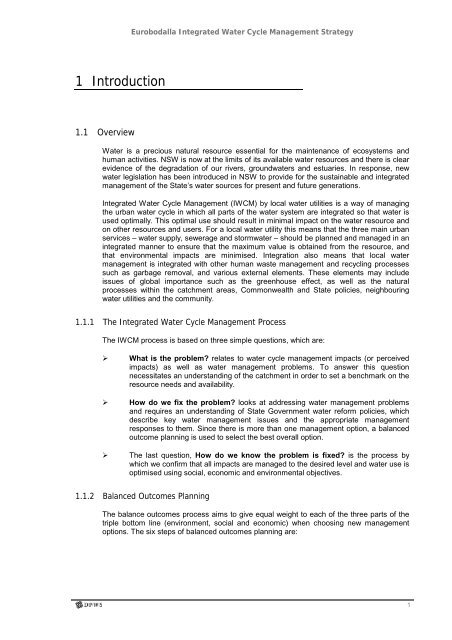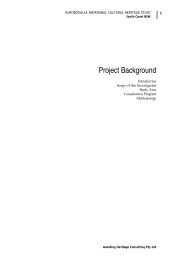Eurobodalla Integrated Water Cycle Management Strategy
Eurobodalla Integrated Water Cycle Management Strategy
Eurobodalla Integrated Water Cycle Management Strategy
Create successful ePaper yourself
Turn your PDF publications into a flip-book with our unique Google optimized e-Paper software.
1 Introduction<br />
1.1 Overview<br />
<strong>Eurobodalla</strong> <strong>Integrated</strong> <strong>Water</strong> <strong>Cycle</strong> <strong>Management</strong> <strong>Strategy</strong><br />
<strong>Water</strong> is a precious natural resource essential for the maintenance of ecosystems and<br />
human activities. NSW is now at the limits of its available water resources and there is clear<br />
evidence of the degradation of our rivers, groundwaters and estuaries. In response, new<br />
water legislation has been introduced in NSW to provide for the sustainable and integrated<br />
management of the State’s water sources for present and future generations.<br />
<strong>Integrated</strong> <strong>Water</strong> <strong>Cycle</strong> <strong>Management</strong> (IWCM) by local water utilities is a way of managing<br />
the urban water cycle in which all parts of the water system are integrated so that water is<br />
used optimally. This optimal use should result in minimal impact on the water resource and<br />
on other resources and users. For a local water utility this means that the three main urban<br />
services – water supply, sewerage and stormwater – should be planned and managed in an<br />
integrated manner to ensure that the maximum value is obtained from the resource, and<br />
that environmental impacts are minimised. Integration also means that local water<br />
management is integrated with other human waste management and recycling processes<br />
such as garbage removal, and various external elements. These elements may include<br />
issues of global importance such as the greenhouse effect, as well as the natural<br />
processes within the catchment areas, Commonwealth and State policies, neighbouring<br />
water utilities and the community.<br />
1.1.1 The <strong>Integrated</strong> <strong>Water</strong> <strong>Cycle</strong> <strong>Management</strong> Process<br />
The IWCM process is based on three simple questions, which are:<br />
What is the problem? relates to water cycle management impacts (or perceived<br />
impacts) as well as water management problems. To answer this question<br />
necessitates an understanding of the catchment in order to set a benchmark on the<br />
resource needs and availability.<br />
How do we fix the problem? looks at addressing water management problems<br />
and requires an understanding of State Government water reform policies, which<br />
describe key water management issues and the appropriate management<br />
responses to them. Since there is more than one management option, a balanced<br />
outcome planning is used to select the best overall option.<br />
The last question, How do we know the problem is fixed? is the process by<br />
which we confirm that all impacts are managed to the desired level and water use is<br />
optimised using social, economic and environmental objectives.<br />
1.1.2 Balanced Outcomes Planning<br />
The balance outcomes process aims to give equal weight to each of the three parts of the<br />
triple bottom line (environment, social and economic) when choosing new management<br />
options. The six steps of balanced outcomes planning are:<br />
1

















